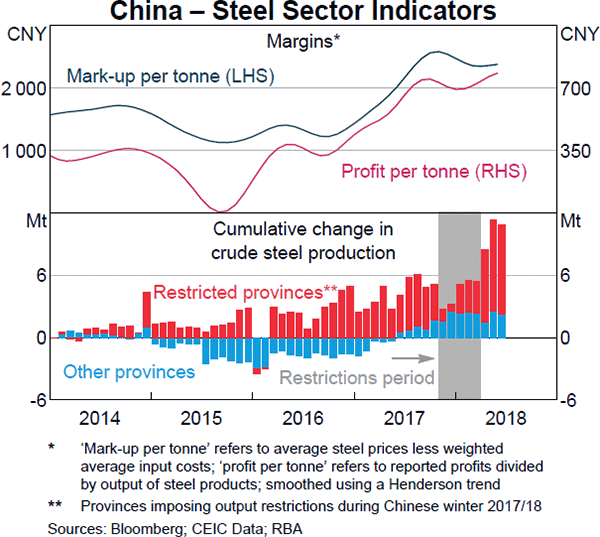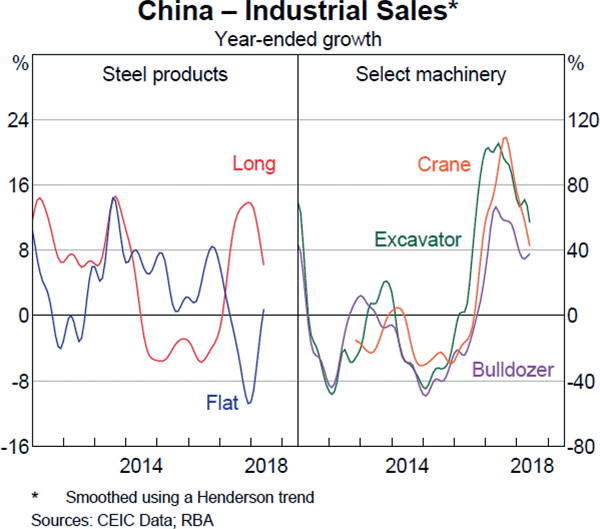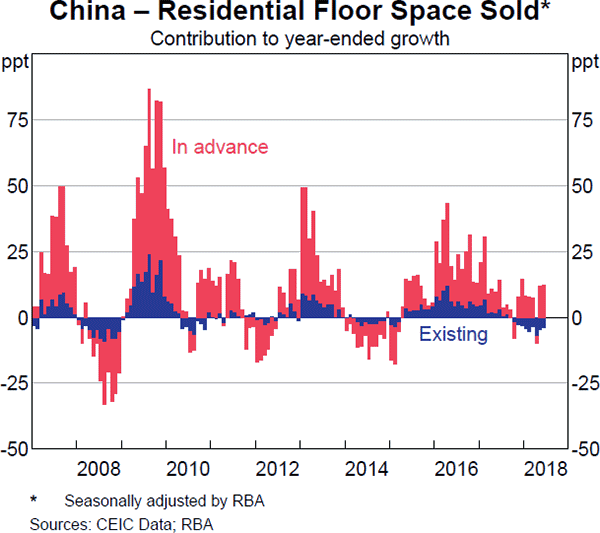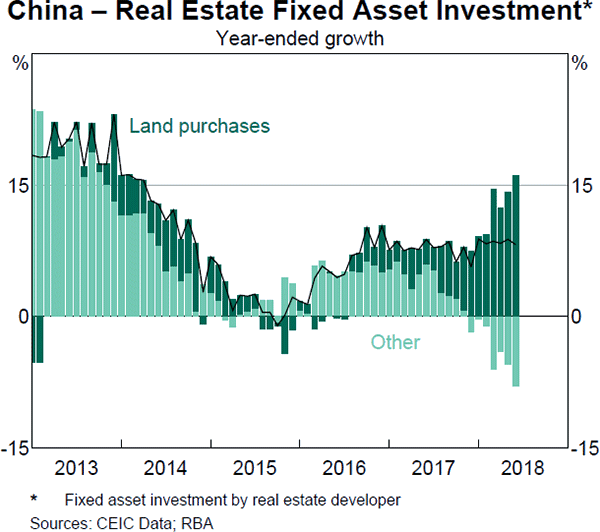Statement on Monetary Policy – August 2018 Box B: An Update on China's Steel Sector
Growth in Chinese crude steel production has picked up strongly in recent quarters. Robust growth in steel output partly reflects the fact that it is currently highly profitable to produce steel; this is because demand has been elevated, many smaller, low-quality producers have exited the market and raw material costs have not increased as much as steel prices. Continued strength of China's steel sector is important because steel production underpins Chinese demand for Australian exports of iron ore and coking coal.
A range of supply- and demand-side factors are currently supporting Chinese steel prices and therefore producers' margins (Graph B1). On the supply side, government efforts in 2016 and 2017 to consolidate the sector and close many small, highly polluting firms resulted in the number of steel firms in China halving since 2015. Some unprofitable firms exited the market, while others were merged and firms using illegal, highly polluting induction furnaces were forced to close.[1] Crude steel output also eased in late 2017 due to environmental policies that restricted production in 28 cities during China's winter months. Production has since rebounded following the expiry of most of the more stringent restrictions in mid March.
Continued strong demand for steel is helping to support prices and margins. Steel sales have grown rapidly over the past year. This growth has been concentrated in sales of long products (such as steel rods and bars to reinforce concrete), which indicates that much of the recent demand is for construction (Graph B2). Consistent with this, sales of machinery typically involved in residential and infrastructure-related construction activity, such as excavators, bulldozers and cranes, have recorded rapid growth. By contrast, sales of flat steel products, such as hot- and cold-rolled sheets or strips that are commonly used in manufacturing (including car production), have been more subdued over the past year.


Forward-looking indicators point to a relatively positive outlook for residential construction activity, suggesting that demand for steel should remain strong. In particular, residential property sales volumes have trended higher in recent months, mainly reflecting advance (‘off-the-plan’) sales of apartments – that is, sales for which there is a commitment to complete construction in the future (Graph B3). Inventories of apartments have declined across much of the country and in some places are now quite low, which should also support future construction.

While steel production is expected to remain high, it is likely to moderate gradually over time from current levels, reflecting structural factors such as slowing urbanisation and falling population growth.[2] In the near term, there are risks to this projection in both directions. On the downside, growth in investment undertaken by real estate developers in the year to date has been entirely driven by land purchases, which implies that actual construction work is declining (Graph B4). Growth in infrastructure investment (parts of which are very steel intensive) has also fallen recently because the central government has increased oversight of local government finances and scrapped public-private partnership projects that were violating limits on state involvement. The contrast between the strength in crude steel output and the recent weakness in investment in these steel-intensive sectors has surprised some market commentators. The weakness in these sectors could lead to steel demand being weaker than expected.

On the upside, however, strong growth in land purchases may instead signify a desire by developers to replenish land stocks in advance of future building work. Moreover, in response to the weakness in infrastructure investment, the government has made several recent policy announcements that signal its willingness to support major transport and energy infrastructure projects. The forward-looking indicators noted above also suggest that construction activity could rebound in coming months. These factors are likely to continue to support Chinese steel demand, and imports of bulk commodities, in the second half of 2018.
Footnotes
The transfer of production from illegal mills (whose output is not measured in official statistics) to larger manufacturers (whose output is measured) means that the reported increase in output in 2018 to date may be somewhat overstated. [1]
For further details on long-run factors affecting Chinese steel demand, see RBA (2017), ‘Box A: The Chinese Steel Market and Demand for Bulk Commodities’, Statement on Monetary Policy, November, pp 15–17. [2]